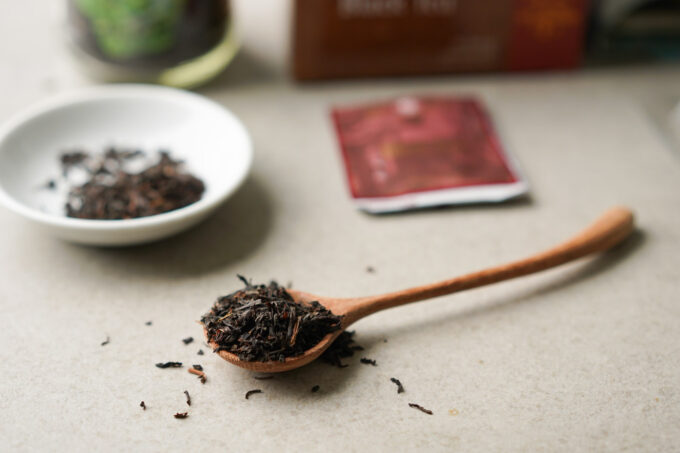Whether you drink tea for its fresh and sometimes earthy taste during a delicious dim sum meal or for its health benefits, this eons-old beverage has found its way around the world as a popular drink. Black tea and green tea are two of the most popular varieties, and between them, there are hundreds of varieties that branch off too.

What is tea?
All types of tea are made from the camellia sinensis plant and originated in ancient China. There’s a legend that it was created in 2737 BCE when the Chinese emperor Shen Nung’s servant was boiling a cup of water and a few leaves happened to fall into the cup. The emperor decided to keep drinking the prepared cup and that’s where it all started.
Tea eventually migrated to other parts of Asia like Japan through Chinese monks visiting the country and left seeds as parting gifts. When travelers and colonialists from Europe began writing about and drinking tea during the 17th century, the fascination expanded and soon was on cargo ships (like the East India Company) to the Western world. Tea was so precious and it was typically drunk by elites and royalty.
Tea is typically broken down into different categories even though most of them come from the camellia sinensis plant (note, herbal tea does not). Some categories are black, green, oolong, and white tea. Each one is named so due to how it’s processed before and after the leaves are picked from the plant.
Some of the most popular types are green tea and black tea–if you’ve ever had dim sum or eaten at an Asian restaurant, you know these are standards in any dining situation to help guzzle down all that tasty food.
What is green tea?

A majority of green tea is made from the camellia sinensis sinensis variety from China and is grown in sunny and dry climates. Most green tea is made by picking the leaves and quickly processing them before oxidation occurs. Oxidation is the process where tea leaves are exposed to the air, which causes them to dry out and brown–this process changes the flavor of tea and makes it bolder and sometimes richer.
Varieties
There are several varieties of green tea and they each have their own flavors and origin. A few varieties are sencha, gunpowder, matcha, and jasmine. The flavors for green tea range from light and sweet to earthy and grassy. They also differ in color, for instance, jasmine tea has a light to golden yellow coloring, while matcha is known for its vibrant green hue.
Tea, in general, is made of plant chemicals called polyphenols that are rich in antioxidants and potentially have anti-carcinogenic and anti-inflammatory characteristics. One type of polyphenol available in tea is flavonoids, which are abundant in a variety of teas like black and green tea as well as other vegetables and foods naturally.
My favorite types of drinks for green tea are boba milk tea, iced matcha green tea, and taro milk tea.
Flavonoids in green tea
When green tea is brewed in a 100-milliliter serving, it contains 133 milligrams of flavonoids. A 100 milliliter serving of black tea contains 119 milligrams of flavonoids. This discrepancy is due to the oxidation process for black tea leaves because the browning of the leaves causes some degradation in flavonoids.
What is black tea?

Black tea is typically made from the camellia sinensis assamica variety that originated from the Assam district of India. This darker type of tea is made by using leaves that are fully oxidized before they are processed and dried.
What does black tea taste like?

The flavor profile for black tea can range anywhere from slightly sweet nutty notes to smoky and malty. It’s typically stronger and bolder in flavor than green tea varieties. Some people may experience some astringency when drinking black tea, but it should not come off bitter–this means it was most likely brewed incorrectly.
There are also what is known as blends of black tea that you may have heard of previously: earl grey tea, English breakfast tea, and masala chai. These types of teas are made with black tea but are mixed with other ingredients like bergamot oil, Ceylon, cardamom, and other ingredients to make blends.

My favorite recipes for black tea are milk tea with boba and Thai iced tea.
Flavonoids in black tea
While black tea has slightly lower amounts of flavonoids due to its oxidation process, there are studies that black tea (in addition to green tea) has antihypertensive properties among other potential health benefits. Further research is definitely required, but there are a lot of studies that go into further detail about drinking black or green tea and the benefits of including it in your diet.
Differences between green tea and black tea

- Flavor profiles: Green tea and black tea have an abundance of different varieties between them and each type of tea has different flavor profiles. Green tea can taste any between light and sweet (like jasmine) or earthy and herby (like matcha or sencha). Depending on the type of tea, black tea can taste strong and bold (like ceylon) or malty and rich (like assam).
- Health benefits: Both green tea and black tea have different health benefits based on various studies: various antioxidants, anti-inflammatory characteristics, and more. For instance, both types of tea are filled with anti-inflammatory and antihypertensive chemicals called flavonoids, but green tea has more flavonoids because the tea leaves are less oxidized before processing like black tea. However, many of these studies state that there is still a need for further research so take this research with a grain of salt.
- Caffeine content: When comparing caffeine content in an 8-ounce serving, green tea has 25-40 milligrams of caffeine and black tea has 40-60 milligrams of caffeine depending on the tea variety used.









